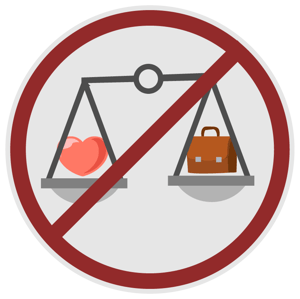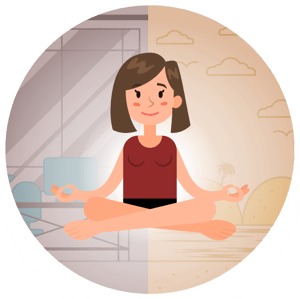Work-Life Balance
In this guide to work-life balance...
We'll look at what healthy work-life balance is, why it seems so hard to achieve a healthy work-life balance, and seven quick-start strategies for improving your work-life balance, whether you're a CEO, just starting your professional career, or anywhere in between.
Table of Contents
Table of Contents
If you’re reading this, you’re like a lot of people: interested in work-life balance and convinced that it can help you to lead a fuller, happier, more meaningful life. But do we understand what work-life balance is? Because, if we’re going to pursue work-life balance, it’s going to be important to know what it is. Otherwise, how will we know if we’re achieving it?
It’s often easier to understand ideas through pictures, so we’ve put together a few graphics to illustrate what work-life balance is and what it’s not. We'll end this section by combining elements of a few of these pictures to give a useful definition of work-life balance.
Equal balance

In this original definition of work-life balance, both are held as equally important and so equally deserving of our time and attention. This leads to the process of trying to clearly distinguish between which parts of our time and attention are being given to work or personal pursuits, and then divvy up that time and attention evenly.
As we’ll see in coming pictures, this definition leaves a few things to be desired. Even so, it’s a helpful image because it at least raises the idea as something for us all to consider.
Work-life balance isn’t a thing
 Have you ever seen a toddler smash together two different colors of play dough? Once they’ve really worked over the dough, it’s impossible to pull it apart into its separate colors again. That’s the counterpoint this view is making to the “equal balance” view above: Work and life aren’t completely separate things that we can pull apart and precisely measure out. Rather, we need to think about them as one whole.
Have you ever seen a toddler smash together two different colors of play dough? Once they’ve really worked over the dough, it’s impossible to pull it apart into its separate colors again. That’s the counterpoint this view is making to the “equal balance” view above: Work and life aren’t completely separate things that we can pull apart and precisely measure out. Rather, we need to think about them as one whole.
While this is a good corrective to the “equal balance” view, it goes a little too far: work and personal life may not be two entirely separate things, but neither are they one homogenous pursuit. We all say and do things in our work that we wouldn’t give time or attention to in our personal lives, and vice versa.
So, this take on work-life balance is helpful in that it brings a sense of holism to our thinking: work and life are not entirely separate things. We’ll take that insight as we develop our own working definition of work-life balance.
The ability to make choices between work and life
 This might be obvious to some, but it's worth noting that work-life balance is something we have to do – not something that's being done to or for us. So it's important to recognize the role that decision-making plays in our work-life balance.
This might be obvious to some, but it's worth noting that work-life balance is something we have to do – not something that's being done to or for us. So it's important to recognize the role that decision-making plays in our work-life balance.
Even if our work-life balance could be decided and managed for us (by governments or technology or our employers), that wouldn't be an ideal situation. Because that balance would be imposed. Decided for us. And one of the important facets of being human is this very opportunity to creatively choose when and where and how we will engage with work and life.
Work-life balance has a creative and personal component to it, where we are navigating and deciding the sort of lives we want to lead. We will add this aspect of creative decision-making to our growing definition of what healthy work-life balance actually means..
The pursuit of satisfaction in both work and life
 So far, we’ve recognized that work and life are separate, but intricately connected. And we've touched on the idea that a healthy work-life balance gives us the ability to creatively choose how we’ll engage with work and with life.
So far, we’ve recognized that work and life are separate, but intricately connected. And we've touched on the idea that a healthy work-life balance gives us the ability to creatively choose how we’ll engage with work and with life.
The important thing to note here is the idea of satisfaction. Because it’s one thing to be able to choose between work and personal pursuits; it’s another thing to look for satisfaction in both arenas. Again, it’s possible to devote equal time to each arena and call that a sort of balance. But if we view one arena as the one where we underperform and suffer so that we can do well in the other, that’s not really a healthy balance. Even worse, if we achieve a balance in our work and personal lives, but are unsatisfied in both arenas, have we really gained anything with our balance?
So, the idea here is that a healthy work-life balance isn’t pursuing balance for its own sake — it’s pursuing balance in order to foster satisfaction in both work and life.
Looking for ways to have work and personal life support – not compete with – each other
 With this last picture, we want to introduce the idea that a healthy work-life balance looks for ways that your work and life can support one another instead of compete with each other.
With this last picture, we want to introduce the idea that a healthy work-life balance looks for ways that your work and life can support one another instead of compete with each other.
Because our time and energy and attention are not unlimited, it's reasonable to think of work-life balance as a zero-sum game where every gain in one arena comes at the expense of the other. And this can be true – there are times when we will have to make sacrifices in one to support the other. But it is also true that gains in one area can foster growth in the other.
Think about it this way: if you experience growth in your personal life, isn't it likely that you'll bring this improved outlook and mindset to your work? So we want to reframe work-life balance to open up the possibility that we can make changes that will support work and life in turn (if not simultaneously). Rather than playing a zero sum game, we’ll be looking for creative solutions that help our work and personal lives to support and enrich one another.
Putting all the pictures together
Taking all of these pictures and the insights they give us, we have the following working definition for healthy work-life balance:
Work-life balance is an ongoing process where we creatively choose where to invest our energy so that work and life don't compete with each other, but support and enrich one another.
The Struggle Is Real: Work-Life Balance Obstacles & Benefits
Chapter Two

Sources:
Society for Human Resource Management: Workplace Flexibility Study
IGDA: Why Crunch Modes Don't Work
American Sociological Review: Changing Work and Work-Family Conflict
Bloomberg: The Increasing Call for Work-Life Balance
Predictors of Physician Career Satisfaction, Work-Life Balance and Burnout
Families and Work Institute: Workplace Flexibility in the United States
Work-Life Balance and Burnout as Predictors of Job Satisfaction in the IT-ITES Industry
The Evolving Definition of Work-Life Balance
Harvard Business Review: Burnout Is a Problem with the Company, Not the Person
Five Really Smart People Share About How To Improve Work-Life Balance
Chapter Three
Four realities we must embrace to improve work-life balance
Nigel Marsh is the author of Fat, Forty and Fired. As he recounts in this talk, “I was eating too much. I was drinking too much. I was working too hard, and I was neglecting my family.” After making some radical changes to the way he approached work-life balance, and taking years to test his approaches, he’s come out on the other side with some wonderful observations and recommendations for improving work-life balance.
Designing your life
Sometimes, our problems with balancing work and life come down to “getting stuck.” But as Stanford’s Bill Burnett shares, there’s a difference between feeling stuck and actually being stuck. And in either case, he and his collaborators at Stanford’s d.School have uncovered a number of proven strategies for designing a life where your work and life are not only balanced, but creatively support one another to create a meaningful life.
“Can we have it all?”
Usually, when people ask this question, they’re asking whether it’s possible to be fulfilled both at work and at home. Just as usually, this question is gendered with the assumption that men are disinterested in home life and women belong in the home. Anne-Marie Slaughter is in a unique position to answer this question as she helped shape public policy related to workforce gender equality and workforce flexibility with the U.S. State Department. But she also shares her story as a highly accomplished professional who went through her own struggles of work and family life balance even as she sought to make changes to how America publicly engages with these issues.
How we define “success” shapes work-life balance
Alain de Botton is a philosopher and author focused on the way various philosophies can influence the everyday lives of people. He says "In the modern world, it’s perhaps easier than it ever has been historically to make a good living. It’s perhaps harder to than ever before to be free of anxiety in our careers." In this humorous, insightful TED Talk at Oxford, Alain shares the demographic data of people who are labelled as “losers” in the developed world. And he makes a compelling argument that much of the suffering we experience in our work stems from unhelpful beliefs we have about what “success” is and how we achieve it.
“You have 168 hours every week”
Laura Vanderkam studies how people spend time. But she has a special interest in how executives and industry top-performers spend their time differently than others. In this TED Talk, she shares a few common themes she sees in those people who see time as an elastic thing that they can shape to lead the lives they want.
Seven Strategies to Improve Work-Life Balance
Chapter Four
Now that we’ve covered what work-life balance is, why it’s a struggle to maintain, and some excellent ideas from leading thinkers and researchers, let’s synthesize everything we’ve learned into a set of strategies we can all use to achieve and maintain better work-life balance.
1. Don’t start with balance, start with what you want.
It might sound strange to start off a list of work-life balance strategies by saying “don’t start with balance,” but we need to revisit a few of the pictures at the beginning of this guide and what we know about human motivation. It’s important to remember that work-life balance isn’t an end in itself. It’s not the ultimate goal; it’s a means to living full, meaningful lives.
So the first strategy, before you pursue better work-life balance, is to answer this question: “What do you want your work-life balance to get for you?” Or, put another way, “What would a full and meaningful life look like for you?”
Keeping the answers to these questions in mind will help focus your efforts as you work to improve and maintain your work-life balance.
2. Put yourself in the right environment.
This came up in the infographic and also in Anne-Marie Slaughter’s TED Talk on work-life balance: some organizations have a culture that supports a healthy work-life balance and recognizes how that balance improves morale and productivity. Some companies don’t have this sort of culture. And beyond companies, there are whole career fields that seem to have poor work-life balance built into them, as though it is just part of the job. On the flip-side, there are jobs and industries that have low stress built right into them.
Regardless of whether it’s the career field, or your particular organization or team, the strategy is to recognize the role that environment plays in your work-life balance. If you have an environment where work-life balance is supported, how can you leverage that support? If you’re in an organization or career where healthy work-life balance is unsupported, one strategy is to start looking for ways to either improve your immediate environment or look for a new one.
If this strategy seems too daunting, that’s totally understandable. Carving out a supportive space or changing work environments altogether can be a large undertaking, especially when your work-life balance is already strained. And while we have five other strategies that you can start with instead, it’s important to at least recognize the ongoing influence that your work environment is going to have as you look to improve your work-life balance. If you have the means to alter your environment in favor of better balance, it’s worth the effort.
3. Start the conversation with your boss.
Of all the people connected to you at work, your boss has the most power to support your work-life balance. They can help structure work days and provide work location flexibility. They may be able to think of other solutions to support a healthy balance.
So whatever strategies you pursue for work-life balance, it’s good to have your boss in the loop. He or she has a vested interest in your viability as an employee, and a good boss will hopefully care that you feel healthy and fulfilled in your work and personal life. Especially since both your viability and health are supported by work-life balance. So start having the conversation with your boss and keep bringing up the topic periodically, because work-life balance is like physical balance: it requires attention and adjustment over time.
Note: If you are the boss and you’re reading this guide, then your work-life balance becomes even more important. Whether you like it or not, you are modeling for your people what sort of work-life balance is normal for the team. And if you’ve read this far in the guide, you know that healthy work-life balance promotes morale and productivity while reducing employee turnover. So your work-life balance has an amplified effect on the productivity of your team. We point that out — not to put extra pressure on you as a leader — but because we’ve come across many service-minded leaders who ignore their own work-life balance in order to lighten the load on the team. But this ends up backfiring in the long run. If you’re a leader, your healthy work-life balance is a service to your team. We’re in your corner. Drop us a line if you want help with this.
4. Set firm boundaries with your technology.
Intrusive technology (being “always on”) is one of the most-commonly cited reasons for poor work-life balance. And we see this surface in a couple ways. The first is the way that technology interrupts our mindful work: we may start out the day with a clear list of tasks and priorities, but as new emails and texts and instant message notifications come in, they drag us away from our focus on completing the important work we need to complete.
The second way is that, as our technology has gone mobile, it now goes with us wherever we are. We can get work notifications while on a date. We can read stressful work emails in bed.
What this means is that one strategy for improving our work-life balance has to be managing our technology. If we don’t, our technology will manage us — and usually away from a healthy balance of work and personal life.
There are a number of smaller strategies you can use, from removing certain email accounts and messaging apps from your phone (after letting your colleagues your boss know — see strategies two and three) to automating your “out-of-office reply” so you don’t have the expectation of engaging with work on your personal time. But the important part is that we look to use technology where it’s helpful, and put up boundaries around where it’s not.
5. Adopt a “prototype mindset.”
Set the bar low, try stuff, see what works, then try again. This strategy comes from Standford’s d.School and their work around “designing your life” (referenced in the TED Talk earlier). The basic idea is that sometimes we feel “stuck” in our lives and so there’s a lot of inertia and fear of the unknown that we have to overcome in order to improve our work-life balance.
Enter prototyping: set the bar low so that fear of the unknown or failure won’t keep you from trying. Pick something that you can accomplish relatively easily in regards to work-life balance. This way, you can make the attempt (“try stuff”) and see what works. By setting the bar low and trying stuff, we get feedback to tell us whether or not we’re moving in the right direction. This gives us the information we need to try again: set another low bar, make another attempt, get more feedback and keep making improvements to our work-life balance.
6. Start with small, high-value changes.
There are two temptations when we go to improve our work-life balance. The first is doing nothing because we feel stuck, or our familiarity or habitual responses kick in to keep us functioning just as we have been (we talked about this temptation in the prototyping strategy above). The second temptation is to try to make big changes to everything: get a new job or change career fields entirely, and get rid of all technology, and try to change work teams and get a new boss.
But this type of wholesale change isn’t always needed. Second, making a lot of large changes simultaneously can sometimes muddy the waters such that we’re not sure which changes are actually doing the most work to improve our balance. Lastly, this approach to change goes against what we know about long-term change: the more change we take on simultaneously, the more likely we are to fail.
So, if we want to improve our work-life balance, we want to look for small, high-value changes so that work and personal life support one another. Take the example Nigel Marsh shared in his TED Talk: he got off work one hour early on one day in order to pick up his son from school. This extra hour allowed him time to go to the park with his son and play games, which then transitioned into dinner together, stories before bed and then tucking his son in for the night.
That was a massively valuable experience, but only required one hour of work time in exchange. There was no need for a new job or a new boss; just one hour of work and intentional presence enjoying time with his son.
What are some small changes you could make that would cost you relatively little work time, but would yield high value in your personal life? Answering this question will lead to a healthier work-life balance.
7. Make friends with your calendar.
Finally, if you’re going to improve your work-life balance, you’re going to need to make space for both. Your calendar will help keep you on point with your work so that it doesn’t spill over into time for yourself and/or your family. Your calendar will help you carve out space for those small changes you’re going to make that will yield high value in your personal life.
In a sense, your calendar embodies what you value in your life — what it is you want out of your work and life. So set your calendar intentionally, set it before you go into your workweek or your workday, guard it from being filled by things that don’t support your goals, and keep coming back to it when you lose focus.
More Resources for Improving Your Work-Life Balance
Chapter Five
We hope that the above strategies will help you to start improving your work-life balance, starting today! But we know this can be a difficult process for some, so we'll also offer a few resources that we've found can help people in their path to achieving a healthier work-life balance.
1. You can take this guide with you. We've put it in e-book form, and you can access all the information and strategies whenever you like. Download below.
2. We've created a tool you can use to help identify what your most-important priorities are and how you feel you're doing in relationship to each. This is a really useful process as part of strategy one ("Don't start with balance, start with what you want."), outlined above.
3. If you'd like to assess where your work-life balance is at, we've created this short check-list that you can use monthly to gauge how you're progressing towards a healthy work-life balance
We hope this guide has been helpful as you look to build a full, meaningful life where your work and personal life come together to enrich one another!
Types of Coaching Sessions
Chapter Five
As mentioned earlier, mindset coaches provide you with unbiased feedback to help you improve. Every once in a while, we need to get a big old slap in the face. A wake-up, cold-water-shower kind of pattern-breaking. The people you know and love may not have what it takes to give you a wake up call. They may not know how to give you one. They may not even recognize that you need one.
On the other hand, a mindset coach is trained specifically to give you that wake up call. Coaches help people break their patterns in order to get to where it is that they want to go. This pattern-breaking can be done in workshops, one-on-one work, or a combination of both. Each experience has its own benefits. Each one has drawbacks. Below is a description of what each scenario could look like for you.
Workshops
Workshops help individuals by showing the coachee that others are going through the same or very similar issues. We are often tempted to keep our struggles to ourselves, because we believe we are the only ones feeling the way we do. However, by sharing our stories, we often find solidarity. We find a community of people who have the same struggles, which actually helps lighten the load.
Group settings also promote collaboration. Even the most solitary job positions require some sort of communication at some point. It could be just with a client, or it might be with another employee. Whatever form it comes in, collaboration is inescapable in the workplace. It only makes sense, then, to bring that environment to coaching.
In business, people have meetings to improve the business but not specifically to improve the people. This is why workshop collaboration can be so useful. It’s a great way to arrive at a solution. Individuals working to improve themselves might be able to accomplish something. But when you put a bunch of people who are looking to improve in a room together, things can really get moving.
Just like coaching itself, workshops provide you with an objective lens through which you can see yourself. You can bounce ideas around with others and hopefully get some tips on how to pull yourself out of your rut. Through shared experiences, workshop attendees can help each other grow.
One-on-one
One-on-one coaching is also incredibly useful when it comes to effecting change in your life. When you choose a one-on-one approach, you get a coaching strategy tailored to your needs and desires. Instead of fulfilling a common goal, you can choose for yourself what to work toward. Your coach then builds a program that will help you get you to where you want to be.
One-on-one coaching is typically done over the phone. These phone calls will happen regularly, as opposed to workshops, which are usually a single occurrence. Your one-on-one coaching sessions will keep you on task as you work toward your set goals. Coaching in this format is best for people who want focused, individualized assistance. If you’re interested in the exact process, check out this article we wrote on one-on-one business coaching.
Title of Asset
Form Title
Form Subtitle
Sit amet, adipiscing urna eget magna duis ut. Fames eget turpis egestas aliquet. Velit massa elit vestibulum turpis nibh semper.

